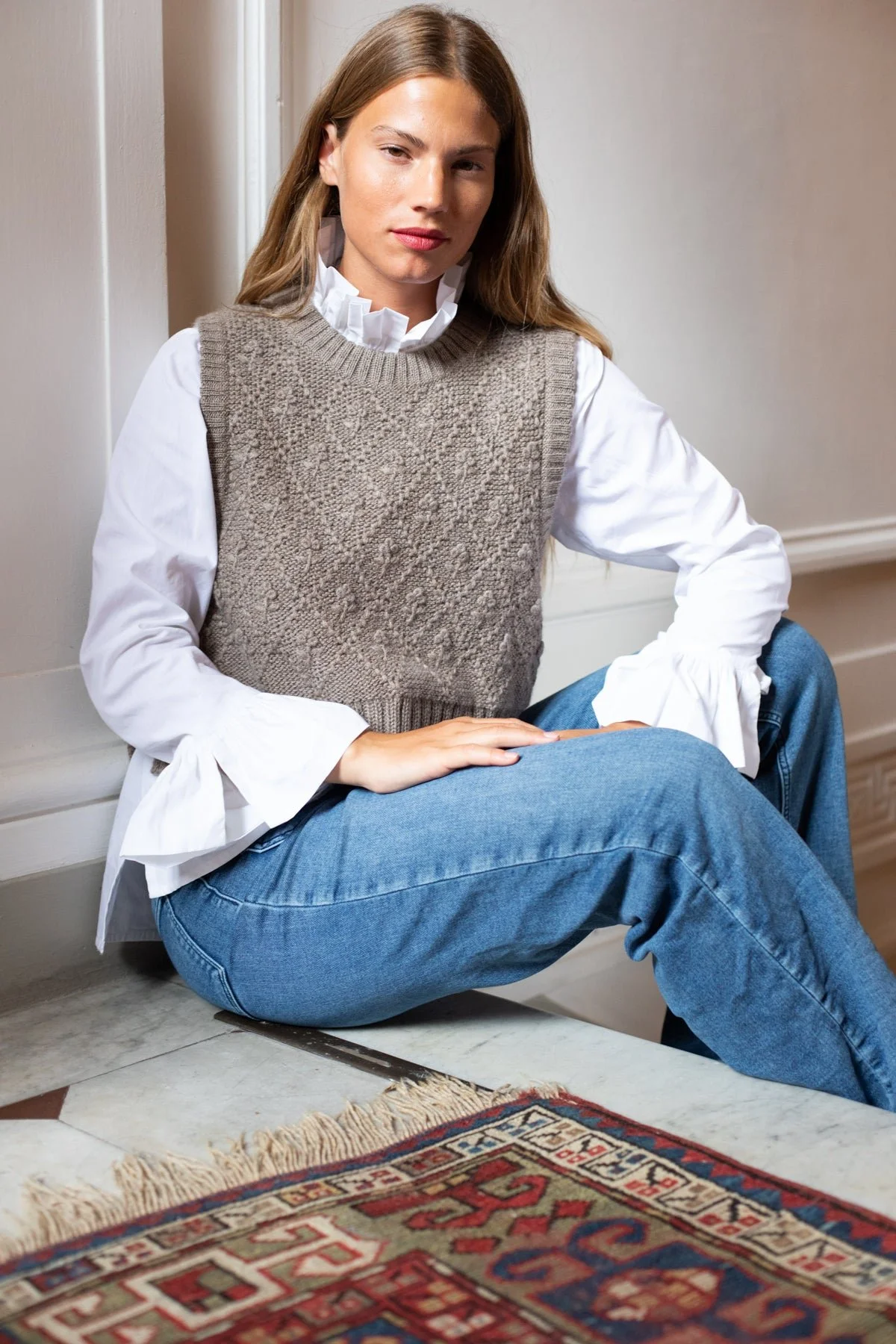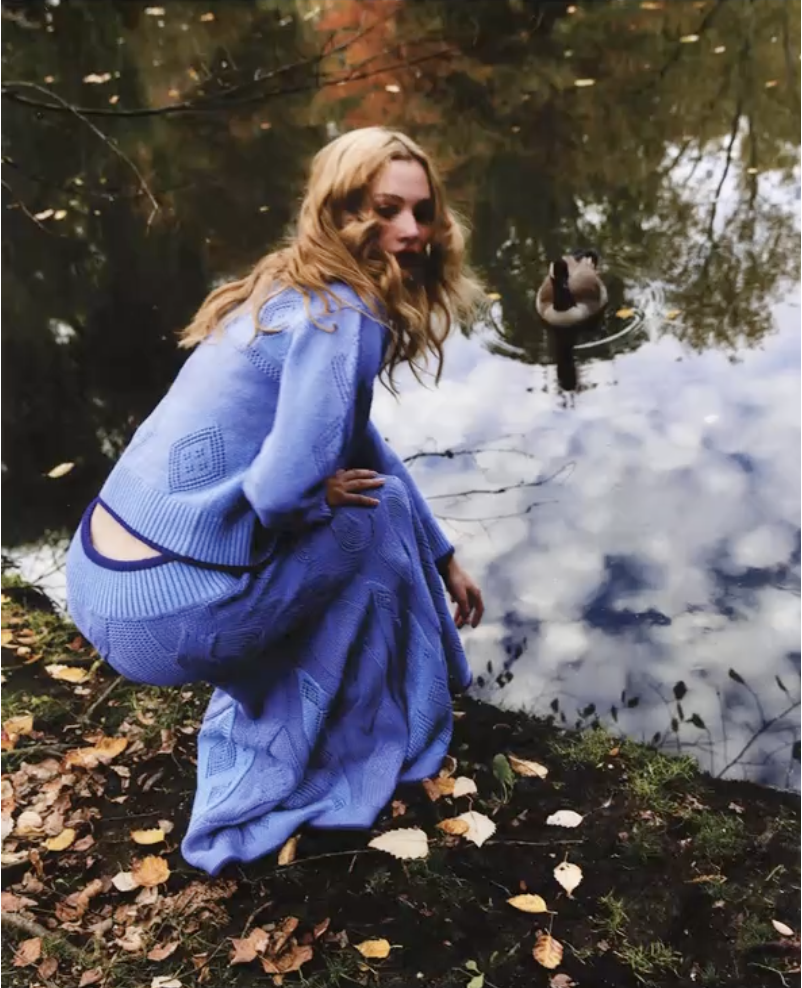
Parker Zinn AW25 Case Study
Together, we expanded beyond domestic manufacturing to develop Parker Zinn’s AW25 collection with Peruvian partners - strengthening her creative vision, refining process, elevating quality, and building a foundation for sustainable growth.
A little about my Client:
Founded by Parsons graduate Parker Zinn, the brand grew from her thesis collection into a made-to-order knitwear line crafted in New York. Each piece blends Southern kitsch with New York polish, marked by bold proportions and playful detail.
Her dotted rabbit logo nods to punch-card knitting, linking childhood imagination to technical craft. The brand’s promise: garments that feel soft yet are built to last.
Elevating and Scaling - Without Losing the Editorial Edge
The Challenge
When Parker reached out, she was ready to grow her label. She had connected with a Peruvian manufacturer but needed guidance to translate her creative vision into production.
The goal was to scale beyond one-of-a-kind pieces made in New York and transition to small-batch production abroad. Parker wanted to expand her offering, strengthen her technical foundation, and create a process that supported consistent fit and quality while protecting her creative identity.
The Approach
We used the K.N.I.T. framework to bring her vision to scale.
Technical foundation
We developed detailed tech packs for each AW25 style that was being produced in Peru. Sketches and domestic samples were translated into precise documentation for the factory team. Every stitch detail, yarn combination, construction note, POM, size chart, and grading rule was refined to meet industry standards. These tools set Parker up for success and created a healthy foundation for her manufacturing relationships.
Material strategy
We balanced Italian novelty yarns with Peruvian alpaca and cotton blends. The combination allowed Parker to keep her signature texture play while introducing high-grade natural fibers that aligned with her sustainability goals.
Fittings and refinement
Through fittings, we refined proportion, shape, and drape for both domestic and international samples. Each silhouette evolved from an artisan-made prototype into a factory-ready garment that still carried Parker’s hand-touched aesthetic.
Systems and communication
Beyond product, we established structure. Sampling calendars, factory communication templates, and tracking systems were built so Parker could manage development confidently as she expanded overseas.
The Result
The AW25 collection marked Parker Zinn’s transition from domestic made-to-order pieces to international small-batch production.
Hero styles like the Cable Godet Skirt and Pointelle Cardigan defined the collection. Each one balanced sculptural construction with delicate pointelle placements.
This collection laid the foundation for long-term growth.
Expanded product range ready for small-batch production
Consistent fit standards that strengthened brand identity and customer confidence
Industry-standard documentation that improved factory communication
Repeatable internal framework for seasonal development
Cable Godet Skirt
When Parker and I developed her AW25 collection, one of the goals was to explore knitwear that could hold shape and move with the body. She wanted to bring structure into softness.
We used the K.N.I.T. framework to bring that idea to life.
Technical foundation
We built detailed tech packs for production in Peru, translating sketches into clear documentation for the factory. Stitch details, yarn combinations, and grading were refined to meet industry standards, giving Parker a strong base for consistent communication and production.
Material strategy
We balanced Italian novelty yarns with Peruvian alpaca blends to create the right mix of drape and structure.
Fittings and refinement
Through fittings, we adjusted proportion and weight until the skirt moved cleanly without losing shape.
The result was the Cable Godet Skirt, a fully-fashioned piece that combines vertical cables with soft godets. The final fabric balance gave the style a sculpted yet flexible feel—technical in construction, wearable in practice.
Where customer insights meet seasonal refresh.
Evolving staples through subtle fit adjustments and fall colorways rooted in brand DNA.
The Challenge
Sue Sartor’s knitwear had already carved out a loyal following, but customer feedback pointed to opportunities for refinement. Customers loved the pullover vest and barrel cardigan, yet many wanted a more flattering fit that worked both layered and on its own. At the same time, her knit colorways and Fair Isle stitch designs were due for a seasonal refresh, the pieces her customers cherished needed newness and seasonal alignment without losing the brand’s DNA.
The Approach
The season started by carefully reshaping the silhouettes. The pullover vest and cardigan were lengthened and adjusted through the body to create proportions that drape more naturally and flatter across sizes. Fit improvements were guided directly by customer feedback, ensuring the updates felt intentional and wearable.
For color Sue requested grounding the collection in shades her customers had already embraced while weaving in fresh seasonal tones. The Fair Isle stitch was refined and then recolored. Because of the brand’s small-batch nature and timing constraints, we worked with stock-service yarns, a thoughtful constraint that allowed for freshness without compromising delivery timing.
The Result
A more versatile, flattering fit in core knits that aligns with customer expectations.
Seasonal color updates, creating excitement while maintaining brand loyalty.
A refreshed Fair Isle stitch that feels modern yet true to the brand’s artisan identity.
Knitwear that continues to feel like a natural extension of Sue Sartor’s joyful, handcraft-rooted design language.
Collaborations like this are why I love what I do:
Parker’s designs were already full of story and intention. My role was to support that artistry with structure and technical rigor. Once the guardrails were in place, her creativity had room to expand even further.
At Noles Studio, this is what we do best. We help designers grow while protecting the spirit of their work, creating systems that support creativity rather than limit it.






